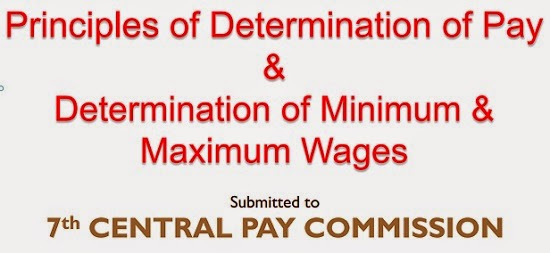Principles of Determination of Pay
&
Determination of Minimum &
Maximum Wages
Submitted to
7th CENTRAL PAY COMMISSION
Indian Railways Technical Supervisors Association
(IRTSA)
| M. SHANMUGAM Central President |
HARCHANDAN SINGH General Secretary |
Compiled by
K.V.RAMESH, Senior JGS/IRTSA
Relevant Terms of reference
- 2.a) To examine, review, evolve and recommend changes that are desirable and feasible regarding the principles that should govern the emoluments structure including pay, allowances and other facilities / benefits, in cash or kind, having regard to rationalization and simplification therein as well as the specialized needs of various Departments, agencies and services, in respect of the following categories of employees:-
- i. Central Government employees-industrial and non- industrial;
- 2.b)To examine, review, evolve and recommend changes that are desirable and feasible regarding principles that should govern the emoluments structure, concessions and facilities/benefits, in cash or kind …….
Article 43. Living wage, etc., for workers
- The State shall endeavour to secure, by suitable legislation or economic organisation or in any other way, to all workers, agricultural, industrial or otherwise, work, a living wage, conditions of work ensuring a decent standard of life and full enjoyment of leisure and social and cultural opportunities and…..
Job Evaluation
- Scientific job evaluation methods are available for a fair comparison of wages.
- Difference in nature of work can well be taken care of in scientific job evaluation.
- Recommendation of 3rd CPC for adoption of Job evolution technique on experimental basis is still not tried.
- Classification or Grading method is easier method for job evaluation.
Proposed method for Job Evaluation
- Brief Job descriptions and details of pay scales, emoluments and other particulars be collected for various group of Employees.
- Jobs can be broadly grouped like “Industrial”, “Non-Industrial” and “Secretarial” etc.
- These groups may be further broken up into various sub-groups like “Artisan”, “Supervisory”, “Administrative”, “Supportive”, etc.
- Separate “Grade definitions” shall be finalised for each of these Groups & sub-groups,
- Indicating, type of work, level of job difficulty, area & Span of Supervision, etc
- Maintaining horizontal parities & vertical relativities.
Will results in
- better justice, better job satisfaction, greater industrial harmony leading to higher efficiency and productivity and the time, cost and effort would definitely be worth the returns, particularly in the long run
Minimum Wage as per 6th CPC method
- Pay in Pay Band + Grade Pay + % DA + Compensation factor based on rise in NNP at factor Cost.
Calculation of compensation factor
| Year | Per Capita NNP at factor cost At constant price | Increase over previous year |
| 2005-06 | 26015 | 1872 |
| 2006-07 | 28067 | 2052 |
| 2007-08 | 30332 | 2265 |
| 2008-09 | 31754 | 1422 |
| 2009-10 | 33901 | 2147 |
| 2010-11 | 36342 | 2441 |
| 2011-12 | 38037 | 1695 |
| 2012-13 | 39168 | 1131 |
| 2013-14* | 41046 | 1878 |
| 2014-15* | 42924 | 1878 |
| % Increase of NNP at factor cost on Constant Prices for the period of ten years |
65%
|
|
| * Assumed figures as per average increase |
||
Proposed Minimum Pay w.e.f. – 1.1.2016
| Minimum Basic Pay + DA 140%+ Compensation factor 65% of BP + DA | |
| Minimum Basic pay after VI CPC | Rs.7000 |
| Projected DA 140% (as on 1.1.2016) | Rs.9800 |
| BP+DA | Rs.16800 |
| Compensation factor (65%) | Rs.10920 |
| Proposed Minimum Pay | Rs.27720 or Rs.28000 |
| Proposed Number of times increase of BP | 3.96 |
Proposed Minimum & Maximum Pay based on post 6th CPC formula
| EXISTING PAY | PROPOSED PAY @ 3.96 TIMES (ROUNDED OFF) OF EXISTING PAY | ||||
| Minimum | Maximum | Minimum | Maximum | ||
| Pay in Pay Band | Grade Pay | Pay in Pay Band | Grade Pay | ||
| Rs.5200 | Rs.1800 | Rs.80,000 | Rs.20,800 | Rs.7200 | Rs.3,20,000 |
- Minimum Pay shall be increased from Rs.7000 to Rs.28,000.
- Maximum Pay Shall be increased from Rs.80,000 to 3,20,000.
- Intermediate Pays shall be fixed in the same way.
- Upgradation shall be granted to specific categories on functional & other related justification.
Determination of Maximum Pay First & then arriving Minimum Pay in the ratio of 9:1
- Maximum Pay shall be fixed first as per rise of NNP and then the Minimum pay in the ratio of 9:1 thereof and the Intermediate Pays shall be fixed.
- Maximum Pay = Rs.80,000 X Compensation factor based on rise in NNP at factor Cost. = 80000 x 3.96 = Rs.316800 or Rs.3,20,000.
- Therefore, Minimum Pay works out to be Rs.320000 / 9 = 35555 or Rs.35500.
Rate of Increments
- Annual Increment:- Rate of annual increment in each grade may please be granted @ 5 per cent.
- Increment on Promotion:- During Promotion minimum 10% increase in Basic Pay has to be granted.
- Fixation of Pay on Promotion at par with Entry Pay:- Pay on Promotion should be fixed at least at par with Entry Pay in the Revised Pay Structure.
Thank you
Source: IRTSA
[http://www.irtsa.net/pdfdocs/7th_CPC_Principle_of_Pay_Determination.pdf]
Stay connected with us via Facebook, Google+ or Email Subscription.
Subscribe to Central Government Employee News & Tools by Email [Click Here]
Follow us: Twitter [click here] | Facebook [click here] | Google+ [click here]
Admin


COMMENTS